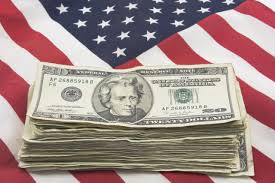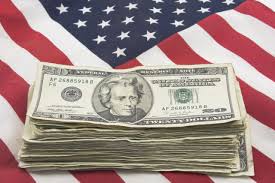
Softening business investment and moderate consumer spending are clouding expectations of a sharp acceleration in the second quarter for the U.S. economy as it slowed less than initially thought in the first quarter.
The Commerce Department said in its second GDP estimate for the first three months of the year that the gross domestic product increased at a 1.2 percent annual rate instead of the 0.7 percent pace reported last month.
That followed a 2.1 percent growth rate in the fourth quarter and was the worst performance in a year.
"Economic indicators so far aren't entirely convincing on a second-quarter bounce in activity and show a U.S. economy struggling to surprise on the upside," said Scott Anderson, chief economist at Bank of the West in San Francisco.
President Donald Trump's ambitious goal to sharply boost economic growth was given a blow bt the first-quarter weakness.
Though administration officials now see 3 percent as more realistic, Trump had vowed to lift annual GDP growth to 4 percent during the 2016 presidential campaign.
Including corporate and individual tax cuts, Trump has proposed a range of measures to spur faster growth. Given weak productivity and labor shortages in some areas, analysts are skeptical that fiscal stimulus, if it materializes, will fire up the economy.
"If the economy is going to grow at 3 percent for as long as the eye can see, businesses better spend lots of money on capital goods. That is not happening," said Joel Naroff, chief economist at Naroff Economic Advisors in Holland, Pennsylvania.
But as first-quarter GDP tends to underperform because of difficulties with the calculation of data that the government is working to resolve, the economy's sluggishness, however, is probably not a true reflection of its health.
The government said inventory investment was far smaller than previously reported and raised its initial estimate of consumer spending growth for the first quarter. And a bit smaller than estimated last month was the trade deficit.
The Federal Reserve is expected to raise interest rates next month despite the tepid growth.
A widening of the goods trade deficit, decreases in inventory investment a modest increase in retail sales last month, and weak business spending have tempered hopes of a sharp rebound even though the economy appears to have regained some speed early in the second quarter.
Unchanged in April for a second straight month was non-defense capital goods orders excluding aircraft, a closely watched proxy for business spending plans, the Commerce Department said in a second report.
After rising 0.2 percent in March, shipments of these so-called core capital goods dipped 0.1 percent. Equipment spending in the government's gross domestic product measurement are calculated using core capital goods shipments.
Between a rate of 2.0 percent and 3.7 percent rate is the estimate of second-quarter GDP growth.
"It looks instead that many companies may be delaying their equipment purchases for now to see if they get a better tax deal later on down the road," said Chris Rupkey, chief economist at MUFG Union Bank in New York.
(Source:www.reuters.com)
The Commerce Department said in its second GDP estimate for the first three months of the year that the gross domestic product increased at a 1.2 percent annual rate instead of the 0.7 percent pace reported last month.
That followed a 2.1 percent growth rate in the fourth quarter and was the worst performance in a year.
"Economic indicators so far aren't entirely convincing on a second-quarter bounce in activity and show a U.S. economy struggling to surprise on the upside," said Scott Anderson, chief economist at Bank of the West in San Francisco.
President Donald Trump's ambitious goal to sharply boost economic growth was given a blow bt the first-quarter weakness.
Though administration officials now see 3 percent as more realistic, Trump had vowed to lift annual GDP growth to 4 percent during the 2016 presidential campaign.
Including corporate and individual tax cuts, Trump has proposed a range of measures to spur faster growth. Given weak productivity and labor shortages in some areas, analysts are skeptical that fiscal stimulus, if it materializes, will fire up the economy.
"If the economy is going to grow at 3 percent for as long as the eye can see, businesses better spend lots of money on capital goods. That is not happening," said Joel Naroff, chief economist at Naroff Economic Advisors in Holland, Pennsylvania.
But as first-quarter GDP tends to underperform because of difficulties with the calculation of data that the government is working to resolve, the economy's sluggishness, however, is probably not a true reflection of its health.
The government said inventory investment was far smaller than previously reported and raised its initial estimate of consumer spending growth for the first quarter. And a bit smaller than estimated last month was the trade deficit.
The Federal Reserve is expected to raise interest rates next month despite the tepid growth.
A widening of the goods trade deficit, decreases in inventory investment a modest increase in retail sales last month, and weak business spending have tempered hopes of a sharp rebound even though the economy appears to have regained some speed early in the second quarter.
Unchanged in April for a second straight month was non-defense capital goods orders excluding aircraft, a closely watched proxy for business spending plans, the Commerce Department said in a second report.
After rising 0.2 percent in March, shipments of these so-called core capital goods dipped 0.1 percent. Equipment spending in the government's gross domestic product measurement are calculated using core capital goods shipments.
Between a rate of 2.0 percent and 3.7 percent rate is the estimate of second-quarter GDP growth.
"It looks instead that many companies may be delaying their equipment purchases for now to see if they get a better tax deal later on down the road," said Chris Rupkey, chief economist at MUFG Union Bank in New York.
(Source:www.reuters.com)





